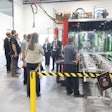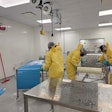WIPOTEC-OCS, a leading manufacturer and supplier of precision in-motion weighing and X-Ray scanning equipment, has introduced a completely redesigned catchweigher for the warehouse and logistics sector that utilizes weigh bridge technology to significantly simplify the weighing process. A first in its affordable price range, the new HC-Warehouse Catchweigher features a single central sensor in the scale’s weigh bridge as opposed to individual strain gauge load cells in each of a unit’s four corners. The result is a streamlined single-sensor weighing process and a drastic reduction in wear and tear.
The HC-Warehouse is the first scale combining WIPOTEC-OCS’ well-regarded weigh bridge frames with strain gauge sensor technology. Designed for a weighing range of up to 50 kilograms, it delivers precise weighing results at transport speeds up to 1.2 meters per second. Its powder-coated steel frame provides exemplary robustness, and differing weighing belt lengths and widths enable flexible integration into existing transport systems. The HC Warehouse scale meets protection class IP44 and is prepared for communication protocols Ethernet/IP, Profinet and Profibus.
With conventional catchweighers, individual strain gauge load cells are positioned on the four corners of weighing platforms, with an item’s weight calculated by synchronizing the individual values reported by each. WIPOTEC-OCS’ weigh bridge technology allows the same precision weighing performed with just one centralized cell. Among other benefits, the setup eliminates the need for weigh-cell maintenance for decreased downtime.
Another feature also radically reduces downtime: predictive maintenance. The HC-Warehouse records in real time all maintenance-relevant data, including lifespans of transport and toothed belts, necessary weigh cell cleaning to combat contamination, and potential drive component imbalances. This information is stored, analyzed and evaluated to calculate the probability for maintenance-centric events. The resulting foresight allows operators to schedule just-in-time maintenance for a timeframe convenient to them, avoiding unexpected downtime and improving Overall Equipment Effectiveness (OEE).













